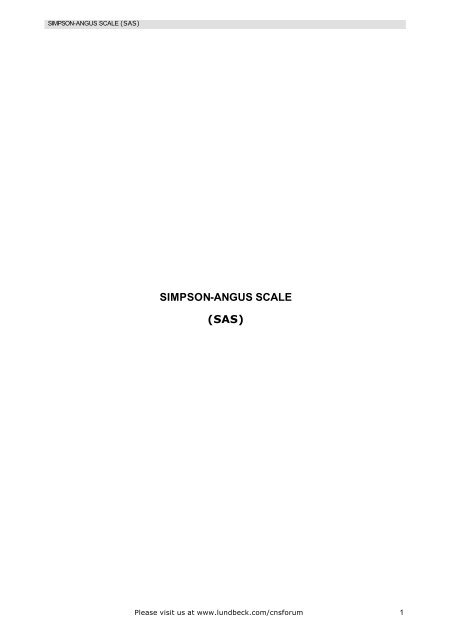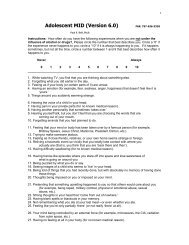SIMPSON-ANGUS SCALE (SAS)
SIMPSON-ANGUS SCALE (SAS)
SIMPSON-ANGUS SCALE (SAS)
Create successful ePaper yourself
Turn your PDF publications into a flip-book with our unique Google optimized e-Paper software.
<strong>SIMPSON</strong>-<strong>ANGUS</strong> <strong>SCALE</strong> (<strong>SAS</strong>)<br />
<strong>SIMPSON</strong>-<strong>ANGUS</strong> <strong>SCALE</strong><br />
(<strong>SAS</strong>)<br />
Please visit us at www.lundbeck.com/cnsforum 1
<strong>SIMPSON</strong>-<strong>ANGUS</strong> <strong>SCALE</strong> (<strong>SAS</strong>)<br />
1. GAIT:<br />
The patient is examined as he walks into the examining room, his gait, the swing of his arms, his general posture, all<br />
form the basis for an overall score for this item. This is rated as follows:<br />
0 = Normal<br />
1 = Diminution in swing while the patient is walking<br />
2 = Marked diminution in swing with obvious rigidity in the arm<br />
3 = Stiff gait with arms held rigidly before the abdomen<br />
4 = Stopped shuffling gait with propulsion and retropulsion<br />
2. ARM DROPPING:<br />
The patient and the examiner both raise their arms to shoulder height and let them fall to their sides.<br />
In a normal subject, a stout slap is heard as the arms hit the sides. In the patient with extreme<br />
Parkinson's syndrome, the arms fall very slowly:<br />
0 = Normal, free fall with loud slap and rebound<br />
1 = Fall slowed slightly with less audible contact and little rebound<br />
2 = Fall slowed, no rebound<br />
3 = Marked slowing, no slap at all<br />
4 = Arms fall as though against resistance; as though through glue<br />
Please visit us at www.lundbeck.com/cnsforum 2
<strong>SIMPSON</strong>-<strong>ANGUS</strong> <strong>SCALE</strong> (<strong>SAS</strong>)<br />
3. SHOULDER SHAKING:<br />
The subject's arms are bent at a right angle at the elbow and are taken one at a time by the examiner<br />
who grasps one hand and also clasps the other around the patient's elbow. The subject's upper arm is<br />
pushed to and fro and the humerus is externally rotated. The degree of resistance from normal to<br />
extreme rigidity is scored as follows.<br />
0 = Normal<br />
1 = Slight stiffness and resistance<br />
2 = Moderate stiffness and resistance<br />
3 = Marked rigidity with difficulty in passive movement<br />
4 = Extreme stiffness and rigidity with almost a frozen shoulder<br />
4. ELBOW RIGIDITY:<br />
The elbow joints are separately bent at right angles and passively extended and flexed, with the<br />
subject's biceps observed and simultaneously palpated. The resistance to this procedure is rated. (The<br />
presence of cogwheel rigidity is noted separately.)<br />
0 = Normal<br />
1 = Slight stiffness and resistance<br />
2 = Moderate stiffness and resistance<br />
3 = Marked rigidity with difficulty in passive movement<br />
4 = Extreme stiffness and rigidity with almost a frozen shoulder<br />
Please visit us at www.lundbeck.com/cnsforum 3
<strong>SIMPSON</strong>-<strong>ANGUS</strong> <strong>SCALE</strong> (<strong>SAS</strong>)<br />
5. WRIST RIGIDITY or Fixation of position:<br />
The wrist is held in one hand and the fingers held by the examiner's other hand, with the wrist n1oved<br />
to extension, flexion and ulner and radial deviation:<br />
0 = Normal<br />
1 = Slight stiffness and resistance<br />
2 = Moderate stiffness and resistance<br />
3 = Marked rigidity with difficulty in passive movement<br />
4 = Extreme stiffness and rigidity with almost a frozen shoulder<br />
6. LEG PENDULOUSNESS:<br />
The patient sits on a table with his legs hanging down and swinging free. The ankle is grasped by the<br />
examiner and raised until the knee is partially extended. It is then allowed to fall. The resistance to<br />
falling and the Jack of swinging form the basis for the score on this item:<br />
0 = The legs swing freely<br />
1 = Slight diminution in the swing of the legs<br />
2 = Moderate resistance to swing<br />
3 = Marked resistance and damping of swing<br />
4 = Complete absence of swing<br />
Please visit us at www.lundbeck.com/cnsforum 4
<strong>SIMPSON</strong>-<strong>ANGUS</strong> <strong>SCALE</strong> (<strong>SAS</strong>)<br />
7. HEAD DROPPING:<br />
The patient lies on a well-padded examining table and his head is raised by the examiner's hand. The<br />
hand is then withdrawn and the head allowed to drop. In the normal subject the head will fall upon the<br />
table. The movement is delayed in extrapyramidal system disorder and in extreme parkinsonism it is<br />
absent. The neck muscles are rigid and the head docs not reach the examining table. Scoring is as<br />
follows:<br />
0 = The head falls completely with a good thump as it hits the table<br />
1 = Slight slowing in fall, mainly noted by lack of slap as head meets the table<br />
2 = Moderate slowing in the fall quite noticeable to the eye<br />
3 = Head falls stiffly and slowly<br />
4 = Head does not reach the examining table<br />
8. GLABELLA TAP:<br />
Subject is told to open eyes wide and not to blink. The glabella region is tapped at a steady, rapid<br />
speed. The number of times patient blinks in succession is noted:<br />
0 = 0 - 5 blinks<br />
1 = 6 – 10 blinks<br />
2 = 11 – 15 blinks<br />
3 = 16 - 20 blinks<br />
4 = 21 and more blinks<br />
Please visit us at www.lundbeck.com/cnsforum 5
<strong>SIMPSON</strong>-<strong>ANGUS</strong> <strong>SCALE</strong> (<strong>SAS</strong>)<br />
9. TREMOR:<br />
Patient is observed walking into examining room and is then reexamined for this item:<br />
0 = Normal<br />
1 = Mild finger tremor, obvious to sight and touch<br />
2 = Tremor of hand or arm occurring spasmodically<br />
3 = Persistent tremor of one or more limbs<br />
4 = Whole body tremor<br />
10. SALIVATION:<br />
Patient is observed while talking and then asked to open his mouth and elevate his tongue. The<br />
following ratings are given:<br />
0 = Normal<br />
1 = Excess salivation to the extent that pooling takes place if the mouth is open and the tongue<br />
raised.<br />
2 = When excess salivation is present and might occasionally result in difficulty in speaking<br />
3 = Speaking with difficulty because of excess salivation<br />
4 = Frank drooling<br />
Please visit us at www.lundbeck.com/cnsforum 6




